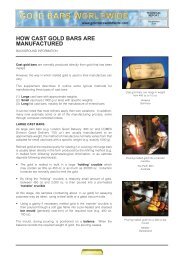Indian Gold Book:Indian Gold Book - Gold Bars Worldwide
Indian Gold Book:Indian Gold Book - Gold Bars Worldwide
Indian Gold Book:Indian Gold Book - Gold Bars Worldwide
Create successful ePaper yourself
Turn your PDF publications into a flip-book with our unique Google optimized e-Paper software.
TRADITIONAL JEWELLERY RETAILERS<br />
INVENTORIES<br />
The inventories of most large and many smaller retailers have increased substantially, especially over the<br />
past 5 years.<br />
Large retailers observe generally that their inventories have increased by 20 - 50% over this period. Many smaller retailers<br />
also report that they have been obliged to increase their inventories.<br />
Reasons include the trend among customers to buy ready-made, rather than customised, jewellery. Many are now insisting<br />
on a much wider variety of “fashionable” pieces to choose from. Retailers have responded to this trend, and fuelled it, to<br />
attract new customers in a static market.<br />
To increase their inventories, many retailers have reinvested their profits, while both large and small retailers appear to be<br />
supported increasingly by wholesalers who offer partial credit terms or consignment stocks at higher prices.<br />
Inventories vary greatly in size. A large retailer may have 30 kg of gold jewellery on display, some 100 kg and more. Many<br />
small retailers have less than 5 kg, some only a few hundred grammes, and even less when they rely on their customers to<br />
provide the gold for fabrication purposes.<br />
Although inventory turnover rates vary considerably, large retailers indicate that a typical average is now likely to be around<br />
3 times annual sales, although in the mid-1990s it was higher at around 4 - 6 times. Among medium size and smaller<br />
retailers, who operate with small inventories and sell more customised jewellery, the inventory turnover rate would be<br />
higher.<br />
Anecdotal evidence suggests that the total amount of gold jewellery held in inventories by retailers nationwide is unlikely to<br />
exceed 400 tonnes of fine gold (equivalent to around 500 tonnes of carat gold).<br />
Inventories tend to be stable. Retailers observe generally that they do not increase their inventories when<br />
the gold price falls, or reduce them when the gold price rises.<br />
To replace the net amount of gold jewellery sold (taking into account the amount of old jewellery exchanged or bought back<br />
for cash), and to preserve the size of their inventory, they usually buy gold on a daily or weekly basis regardless of the<br />
prevailing gold price. They do not speculate on the gold price.<br />
When buying gold bars from bullion dealers, they advise that they rarely keep them in bar form for long. They are normally<br />
converted into jewellery as soon as possible.<br />
Inventories act generally as depositories of family wealth.<br />
In India, most traditional retailers view their inventories differently from retailers in Western countries. Apart from being the<br />
vehicle to retail gold jewellery, inventories also serve as a long-term family investment in gold.<br />
110<br />
Most jewellery retailers are small. Many sell on average less than 50 g of gold jewellery daily.<br />
AN INTRODUCTION TO THE INDIAN GOLD MARKET

















